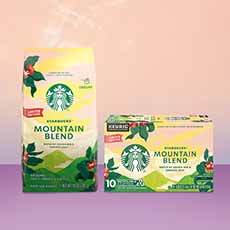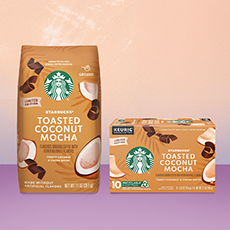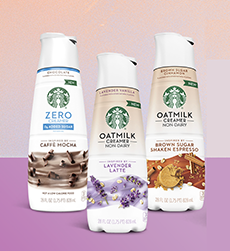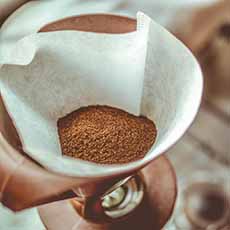Spring Into Daylight Saving(s) Time With Starbucks Spring Flavors
|
|
On the second Sunday in March, clocks are set ahead one hour at 2:00 a.m. and begins a half-year of Daylight Saving Time (DST). So when you go to sleep on Saturday, March 9th, you’ll wake up on Sunday with one hour less sleep. But then, you get more light at the beginning and end of each day. Daylight Saving time lasts for a total of 34 weeks (238 days) every year, about 65% of the entire year. How about a cup of a special new coffee to wake up with on the first day of DST 2025? Starbucks® Coffee At Home knows that the hour of lost sleep leads to the sleepiest Sunday of the year. Few things make a sleepy Sunday better than cozying up in bed with a fresh cup of coffee. Why not make it a special cup? Starbucks’ Spring At Home’s grocery items are ready to join you as you ease into DST. While we have our favorites from the year-round line, we’ve grown so fond of some seasonal specialties that we buy large quantities so we don’t run out (it should be noted that we personally consume up to 6 K-Cups a day). Starbucks’ spring line offers a variety of delicious flavors, blends and coffee formats that include the debut of five new products including: Coffees How important is your morning coffee? A survey conducted by an outside research firm for Starbucks showed just how important it is. The 2025 Wake Up Survey found that: Daylight Saving Time (DST) was first proposed by Benjamin Franklin in 1784, although as a satirical suggestion to save on candle usage by awaking earlier. The modern concept of DST was introduced by George Hudson* of New Zealand in 1895 and later popularized by William Willett† of the U.K. in 1907. The first official implementation took place in Port Arthur, Canada, in 1908. Germany adopted DST nationwide in 1916 to conserve energy during World War I. In the U.S., DST was first implemented during World War I in 1918, as part of the Standard Time Act. It was repealed in 1919 but reintroduced during World War II as “War Time.” After the war, DST became optional, leading to inconsistent observance across the states. The Uniform Time Act of 1966 standardized DST nationwide, allowing states to opt out entirely. Since then, DST has been adjusted several times, including extensions in 1986 and 2007 to its current schedule: starting on the second Sunday in March and ending on the first Sunday in November. Today, most U.S. states observe DST, except for Arizona (excluding the Navajo Nation), Hawaii, and U.S. territories like Puerto Rico, Guam, and the Virgin Islands. Globally, about 34% of countries use DST, primarily in Europe and North America. The practice remains controversial. Proponents argue that it saves energy, reduces crime, and promotes outdoor activities, while critics highlight its minimal energy savings, health risks (e.g., disrupted sleep), and inconvenience. |
|
|
Efforts to make DST permanent have gained traction in the U.S. In 2022, the U.S. Senate passed the Sunshine Protection Act to establish year-round DST, but it failed to pass in the House. The current president has also expressed interest in eliminating DST, calling it “inconvenient and costly.” As of 2025, DST continues to be observed in the U.S. under its current schedule, with ongoing debates about its future. Is the U.S. going to permanently end daylight saving time? In 2022, the U.S. Senate unanimously approved a measure, the Sunshine Protection Act, that would have made daylight saving time permanent across the U.S., however, the legislation was never brought to a vote in the U.S. House of Representatives. > The different types of coffee: a photo glossary. > The history of K-Cups follows. > The year’s 25 coffee holidays. K-cups were invented in the early 1990s by John Sylvan and Peter Dragone, founders of Keurig (now Keurig Green Mountain. Sylvan had previously developed the concept while working at a company that went bankrupt in 1988. His initial idea was to solve the problem of office coffee, which was often stale or wasted when made in large pots. The two marketed the first Keurig brewing system using K-Cups 1998, targeting office use rather than homes. These early machines were bulky and expensive, designed for workplace environments where coffee consumption was high. A home version was needed, and it was released in 2004. The convenience of brewing a single cup quickly with minimal cleanup strongly appealed to consumers. In 2006, Green Mountain Coffee Roasters, a seller of better coffee, acquired Keurig. Green Mountain leveraged its existing relationships with retailers and coffee producers to promote Keurig, and by the 2010s, Keurig single-serve brewers and K-cups had become ubiquitous in American households. The company partnering with major brands like Starbucks, Dunkin’ Donuts, and Newman’s Own to offer their coffee in K-cup format. The fly in the ointment of impressive growth was that the plastic was a significant environmental polluter. In response to environmental concerns, Keurig introduced recyclable K-cups in 2016, though the process is cumbersome. It requires the users to peel off the top of the K-Cup and toss (or compost) the wet grounds. The plastic cup must be rinsed clean before recycling. While committed environmentalists may have taken the time to do this, most consumers did not. The K-cup patent expired in 2012, leading to a proliferation of third-party pods that are compatible with Keurig machines. This greatly expanded consumer options while dumping even more K-cups into the landfill. As of today, several third-party manufacturers have created fully compostable coffee pods that are compatible with Keurig machines. These compostable alternatives typically use materials like plant-based polymers, paper, and other biodegradable substances that break down in industrial composting facilities. The current challenge is to perfect the materials so they can withstand the high-pressure hot water brewing process while still breaking down completely in composting conditions. ‡It’s officially Daylight Saving Time, without the “s.” But Daylight Savings Time is also acceptable. *George Vernon Hudson (1867–1946) was a British-born New Zealand entomologist and astronomer. Longer daylight hours maximized his entomological studies. In 1895, he presented a paper to the Wellington Philosophical Society proposing a two-hour daylight-saving shift. He followed this with another paper in 1898. Although his concept was not immediately implemented, it influenced later advocates of DST. †William Willett (1856–1915) was a British builder and a prominent advocate for DST in the U.K. He independently conceived the idea in 1905 while horseback riding early one summer morning. Observing how many people slept through the early daylight hours, he proposed advancing clocks to make better use of daylight. In 1907, published a pamphlet titled “The Waste of Daylight,” in which he suggested advancing clocks by 80 minutes in four 20-minute increments during April and reversing the process in September. His proposal aimed to save energy, reduce lighting costs, and provide more daylight for recreation. Despite his vigorous campaigning and support from figures like Winston Churchill, Willett’s proposal faced resistance and was not implemented during his lifetime. But they were adopted the year after his death, in 1916, during World War I, as a measure to conserve coal. CHECK OUT WHAT’S HAPPENING ON OUR HOME PAGE, THENIBBLE.COM.
|
||









